|
[1]
|
Z. Aljbory and M. S. Chen, Indirect plant defense against insect herbivores: a review, Insect Sci.,25 (2018), 2–23.
|
|
[2]
|
M. Heil, Indirect defence via tritrophic interactions, New Phytol., 178 (2008), 41–61.
|
|
[3]
|
D. Piesik, K. J. Delaney, A. Wenda-Piesik, et al., Meligethes aeneus pollen-feeding suppresses, and oviposition induces, Brassica napus volatiles: beetle attraction/repellence to lilac aldehydesand veratrole, Chemoecology 23 (2013), 241–250.
|
|
[4]
|
D. Piesik, I. Kalka, A. Wenda-Piesik, et al., Apion miniatum Germ. Herbivory on the MossySorrel, Rumex confertus Willd.: Induced Plant Volatiles and Weevil Orientation Responses, Pol.J. Environ. Stud., 23 (2014), 2149–2156.
|
|
[5]
|
D. Piesik, A. Wenda-Piesik, D. K. Weaver, et al., Influence of Fusarium crown rot disease onsemiochemical production by wheat plants, J. Phytopathol., 155 (2007), 488–496.
|
|
[6]
|
T. C. Turlings and M. Erb, Tritrophic interactions mediated by herbivore-induced plant volatiles:mechanisms, ecological relevance, and application potential, Annu. Rev. Entomol., 63 (2018),433–452.
|
|
[7]
|
V. Ninkovic, A. Al Abassi and J. Pettersson, The influence of aphid-induced plant volatiles onladybird beetle searching behavior, Biol. Control., 21 (2001), 191–195.
|
|
[8]
|
R. D. Girling and M. Hassall, Behavioural responses of the seven-spot ladybird Coccinellaseptempunctata to plant headspace chemicals collected from four crop Brassicas and Arabidopsisthaliana, infested with Myzus persicae, Agr. Forest Entomol., 10 (2008), 297–306.
|
|
[9]
|
M. L. Rosenzweig, Exploitation in three trophic levels, Am. Nat., 107 (1973), 275–294.
|
|
[10]
|
D. J. Wollkind, Exploitation in three trophic levels: an extension allowing intraspecies carnivoreinteraction, Am. Nat., 110 (1976), 431–447.
|
|
[11]
|
M. L. Rosenzweig and R. H. MacArthur, Graphical representation and stability conditions ofpredator–prey interactions, Am. Nat., 97 (1963), 209–223.
|
|
[12]
|
K. McCann and P. Yodzis, Biological conditions for chaos in a three–species food-chain, Ecology,75 (1994), 561–564.
|
|
[13]
|
A. Hastings and T. Powell, Chaos in a three–species food–chain, Ecology, 72 (1991), 896–903.
|
|
[14]
|
R. K. Upadhyay and R. K. I. Satteluri, Introduction to Mathematical Modeling and ChaoticDynamics, Chapman and Hall/CRC, 2013.
|
|
[15]
|
A. Klebanoff and A. Hastings, Chaos in three species food chains, J. Math. Biol., 32 (1994),427–451.
|
|
[16]
|
S. Rinaldi, C. Renato and A. Gragnani, Reduced order models for the prediction of the time ofoccurrence of extreme episodes, Chaos Solition Fract., 12 (2001), 313–320.
|
|
[17]
|
V.RaiandR.K.Upadhyay, ChaoticPopulationDynamicsandBiologyoftheTop-Predator, ChaosSolition Fract., 21 (2004), 1195–1204.
|
|
[18]
|
A. Maiti, A. K. Pal and G. P. Samanta, Usefulness of biocontrol of pests in tea: a mathematicalmodel, Math. Mod. Nat. Phenom., 3 (2008), 96–113.
|
|
[19]
|
N. Pal, S. Samanta and J. Chattopadhyay, Revisited Hastings and Powell model with omnivoryand predator switching, Chaos Solition Fract., 66 (2014), 58–73.
|
|
[20]
|
H. Zhang and P. Georgescu, The influence of the multiplicity of infection upon the dynamics of acrop–pest–pathogen model with defence mechanisms, Appl. Math. Model., 39 (2015), 2416–2435.
|
|
[21]
|
S. Gakkhar and A. Singh, Control of chaos due to additional predator in the Hastings–Powell foodchain model, J. Math. Anal. Appl., 385 (2012), 423–438.
|
|
[22]
|
G. Blé, V. Castellanos and M. A. Dela–Rosa, Coexistence of species in a tritrophic food chainmodel with Holling functional response type IV, Math. Meth. Appl. Sci., 41 (2018), 6683–6701.
|
|
[23]
|
P. Ghosh, P. Das and D. Mukherjee, Chaos to order–Effect of random predation in a Holling typeIV tri–trophic food chain system with closure terms, Int. J. Biomath., 9 (2016), 1650073.
|
|
[24]
|
S. Mandal, S. Ray, S. Roy, et al., Order to chaos and vice versa in an aquatic ecosystem, Ecol.Model., 197 (2006), 498–504.
|
|
[25]
|
Y. H. Liu, D. L. Liu, M. An, et al., Modelling tritrophic interactions mediated by induced defencevolatiles, Ecol. Model., 220 (2009), 3241–3247.
|
|
[26]
|
P. Fergola and W. Wang, On the influences of defensive volatiles of plants in tritrophic interactions,J. Biol. Syst., 19 (2011), 345–363.
|
|
[27]
|
H. M. Poehling, B. Freier and A. M. Klüken, IPM Case studies: Grain, in Aphids as Crop Pests(eds. H.F. van Emden and R. Harrington), CABI, Wallingford, United Kingdom, (2007), 597–606.
|










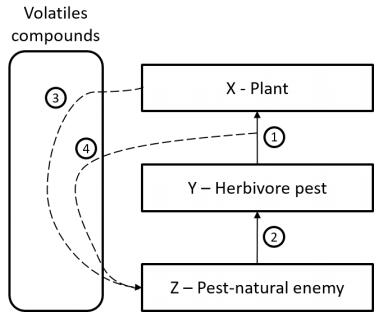
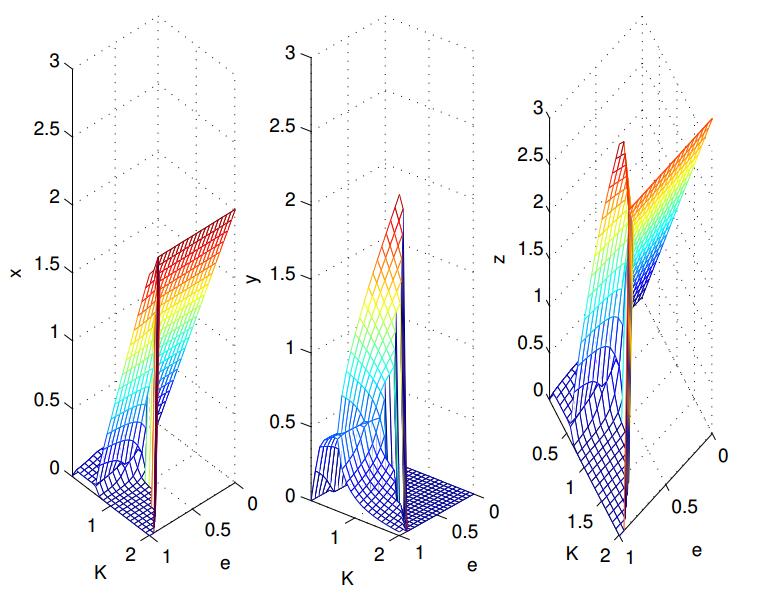
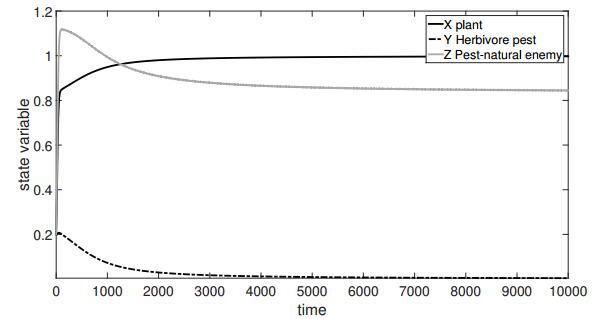
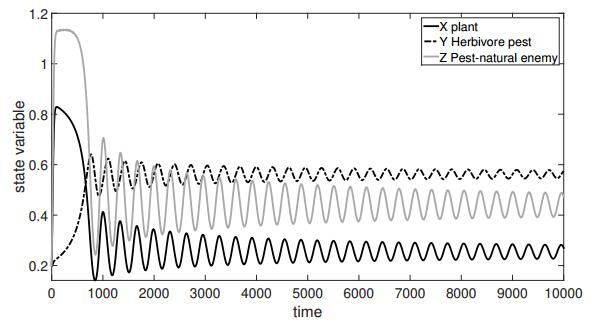
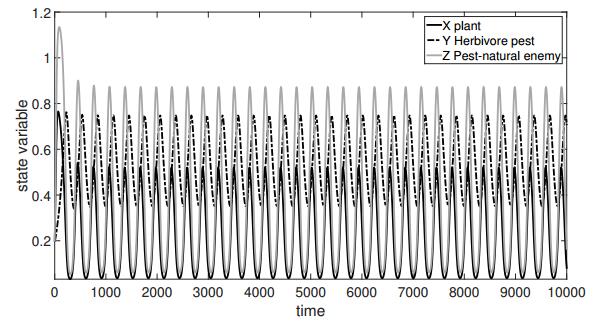
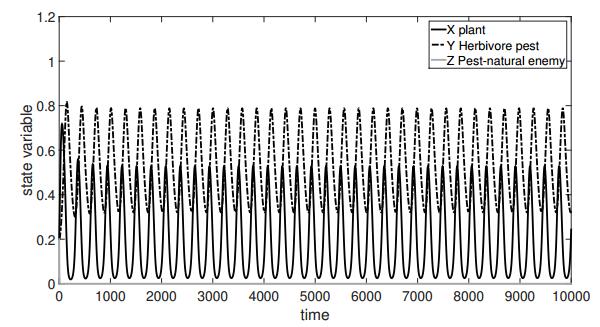
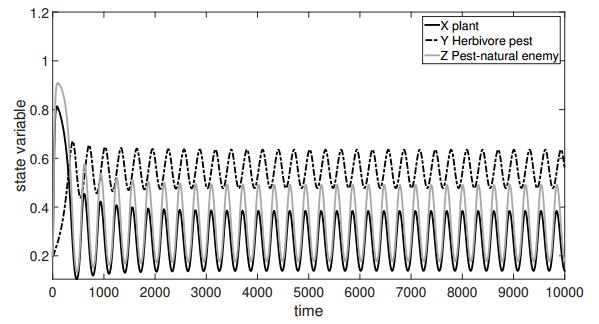
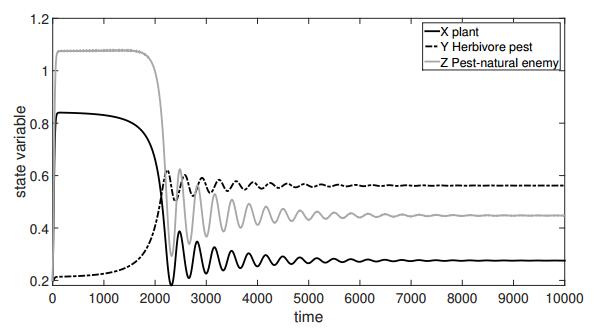

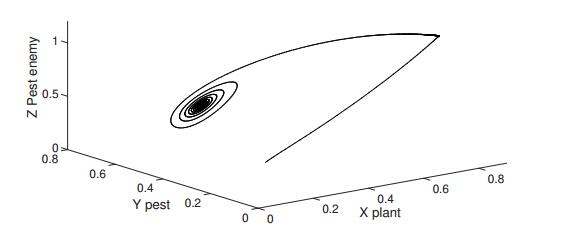


 DownLoad:
DownLoad: